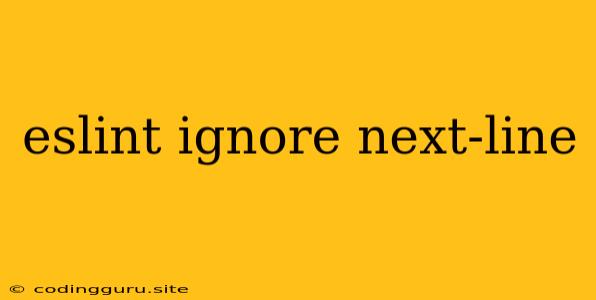Understanding and Utilizing "eslint ignore next-line"
In the world of software development, maintaining code quality is paramount. Linters like ESLint play a crucial role in enforcing coding style and identifying potential issues. However, there are instances where you might encounter situations requiring you to deliberately bypass these rules. This is where the "eslint ignore next-line" directive comes in handy.
What is "eslint ignore next-line"?
The "eslint ignore next-line" directive is a comment-based mechanism provided by ESLint to temporarily disable rule enforcement for the very next line of code. It's a powerful tool that allows developers to maintain code consistency while selectively ignoring specific rules when necessary.
How Does It Work?
The directive is implemented as a special comment at the beginning of the line you wish to ignore. The general syntax is:
// eslint-disable-next-line
Here, <rule-id> represents the specific ESLint rule you want to disable. For example, to ignore the "no-unused-vars" rule for the next line, you'd use:
// eslint-disable-next-line no-unused-vars
const unusedVariable = "This variable won't be used";
When to Use "eslint ignore next-line"?
While it's essential to maintain code quality, there are valid scenarios where using "eslint ignore next-line" makes sense:
-
Temporary Workarounds: When dealing with legacy code or temporary fixes, ignoring specific rules can be helpful while you work towards a more permanent solution.
-
Testing and Debugging: During testing and debugging, you might need to temporarily disable rules that interfere with your code's functionality.
-
Complex Logic: In complex logic where enforcing a rule might lead to unnecessary code duplication or obfuscation, "eslint ignore next-line" can help maintain clarity.
-
Third-Party Libraries: When working with third-party libraries, their code might not always adhere to your project's ESLint rules. In such cases, selectively ignoring rules might be necessary for seamless integration.
Example: Ignoring "no-console" Rule
Let's say you're working on a React component and need to log information for debugging purposes:
function MyComponent() {
// eslint-disable-next-line no-console
console.log("Component mounted!");
return Hello from MyComponent!;
}
The "eslint-disable-next-line no-console" comment will temporarily disable the "no-console" rule for the next line, allowing you to use console.log for debugging.
Best Practices:
-
Be Specific: Always specify the exact rule you wish to disable. Avoid using
// eslint-disable-next-linewithout a rule ID, as it disables all rules for the next line. -
Document Your Reasons: Add a comment explaining why you're using "eslint ignore next-line." This helps maintain code clarity and makes it easier for others to understand your intentions.
-
Avoid Overuse: Use "eslint ignore next-line" sparingly. Frequent use can indicate underlying issues with your ESLint configuration or code structure that should be addressed.
Alternative Approach: Disabling Rules Within Your Configuration
If you need to disable a rule across your entire project or a specific file, you can adjust your ESLint configuration file (.eslintrc.js or .eslintrc.json). This allows you to define the rule's severity or disable it completely.
Example: Disabling "no-unused-vars" in a File
{
"overrides": [
{
"files": ["src/utils/helper.js"],
"rules": {
"no-unused-vars": "off"
}
}
]
}
This configuration will disable the "no-unused-vars" rule specifically for the src/utils/helper.js file.
Conclusion:
The "eslint ignore next-line" directive is a valuable tool that provides flexibility in enforcing coding style and managing exceptions. Used responsibly, it allows you to maintain code quality while accommodating situations where temporarily bypassing rules is necessary. Remember to use it judiciously and always document your reasons for using it, promoting code clarity and collaboration within your team.
